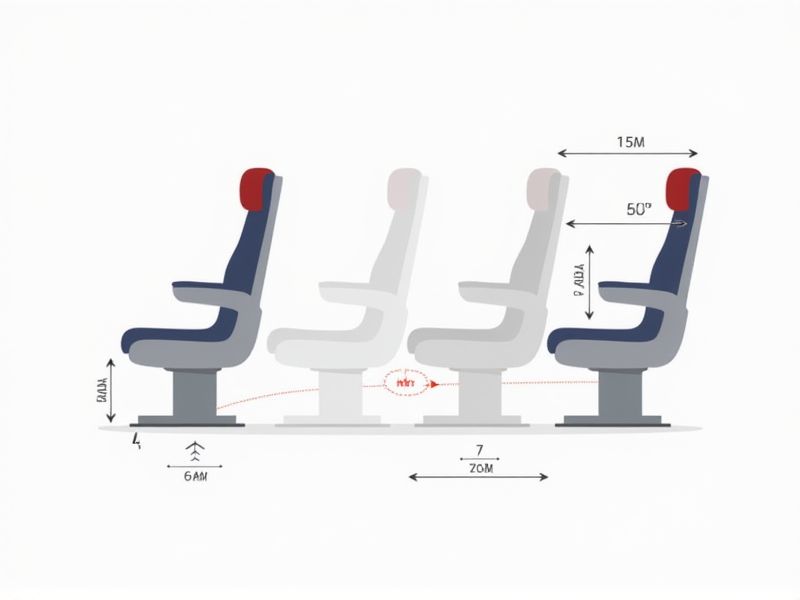
Airplane seat dimensions can vary depending on the airline and aircraft model, but there are some standard measurements you can expect. Typically, economy class seats have a width of 17 to 18 inches, which refers to the distance from armrest to armrest. The seat pitch--meaning the space between a point on one seat and the same point on the seat in front--usually ranges from 30 to 32 inches in standard economy cabins. Knowing these dimensions ahead of time can help you choose a seat that best fits your comfort needs when booking your next flight.
Seat Width
The standard seat width in commercial airplanes ranges from 17 to 18.5 inches, dependent on the airline and aircraft model. A wider seat significantly enhances passenger comfort, especially on long-haul flights, where a reduction in personal space can impact the overall travel experience. Airlines such as Emirates and Singapore Airlines are noted for providing more generous seat widths, often exceeding 18 inches. To ensure a pleasant journey, you may want to consider these dimensions when selecting your flight.
Seat Pitch
Seat pitch, measured in inches, is a crucial factor in airline comfort, typically ranging from 28 to 34 inches in economy class. Low-cost carriers often provide fewer inches, while premium airlines may offer more generous spacing. Increased seat pitch enhances legroom, which can significantly improve the passenger experience during long-haul flights. You might find that airlines with a standard pitch of 31 inches or more are more favorable for your travel comfort.
Legroom
Airplane seat legroom typically measures between 28 to 34 inches, heavily influencing passenger comfort during flights. Airlines have different configurations, with budget carriers often providing less legroom, around 28 inches, while premium cabins may offer 32 inches or more. You can enhance your traveling experience by selecting seats with extra legroom, which might range up to 36 inches, found in exit rows or designated premium seats. Understanding these measurements can significantly impact your choice of airline and seating arrangement, especially for longer flights.
Seat Recline
Airplane seat recline typically allows for a range of adjustments from 4 to 6 inches, significantly impacting passenger comfort on long flights. Many airlines implement a nominal reclining angle of 20 to 30 degrees, which can enhance relaxation during travel yet may intrude on your neighboring passenger's space. The design and mechanism of seat recline are crucial, with modern aircraft often featuring ergonomic contours to better support lumbar regions. Understanding these factors can help you choose a flight that prioritizes your comfort during the journey.
Seat Height
Seat height in airplanes typically ranges from 17 to 19 inches, ensuring proper comfort for a variety of passenger sizes. This ergonomic design aims to support easier entry and exit, while also accommodating the average legroom of approximately 30 to 32 inches. Airlines often adjust seat height to enhance the passenger experience, offering reclining options and lumbar support. When choosing your seat, consider the height specifications to maximize your comfort during travel.
Armrest Width
The standard width of an airplane seat armrest typically ranges from 2 to 4 inches, designed to provide adequate support while maximizing passenger space. This dimension can significantly impact your comfort during flights, especially on long-haul journeys. An armrest that is too narrow may restrict arm movement, leading to discomfort. Manufacturers often prioritize ergonomics, ensuring that the dimensions fit diverse body types and enhance the overall flying experience.
Aisle Width
Aisle width in airplane seating typically ranges from 16 to 20 inches, providing varying levels of accessibility and comfort for passengers. Wider aisles, often exceeding 20 inches, enable easier movement, particularly for individuals with mobility challenges or when serving in-flight meals. Major airlines like Delta and American Airlines have adjusted their cabin designs to prioritize aisle space, improving the boarding and deplaning process for your convenience. Enhanced aisle dimensions can also contribute to increased passenger satisfaction, making air travel a more pleasant experience.
Headrest Height
The standard height for airplane seat headrests typically ranges from 24 to 30 inches above the floor, accommodating passengers of various heights. Many airlines design these headrests to be adjustable, allowing you to customize positioning for optimal neck and head support during flights. Research indicates that proper headrest alignment can significantly reduce discomfort, with 70% of travelers experiencing improved rest when their head is supported correctly. Modern headrest designs often incorporate memory foam or contoured shapes to enhance overall passenger comfort.
Cushion Depth
The standard cushion depth for airplane seats is typically between 2 to 4 inches, designed to provide basic comfort during flights. This depth significantly impacts passenger satisfaction, as deeper cushioning can enhance the overall seating experience, particularly on long-haul journeys. Aircraft manufacturers often consider ergonomic factors, aiming to support the natural curvature of the spine while preventing pressure points. For your next flight, awareness of cushion depth can help you choose a seat that aligns with your comfort preferences.
Backrest Angle
The standard backrest angle for airplane seats typically ranges from 90 to 120 degrees, ensuring passenger comfort during flights. Research indicates that an optimal backrest angle can reduce spinal stress and improve circulation, enhancing overall travel experience. Airlines often design their seats to recline slightly, with most budget airlines allowing limited movement compared to premium carriers. When booking your next flight, consider evaluating seat pitch and backrest specifications to better suit your comfort needs.
